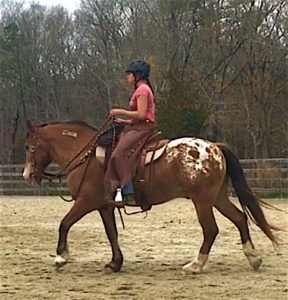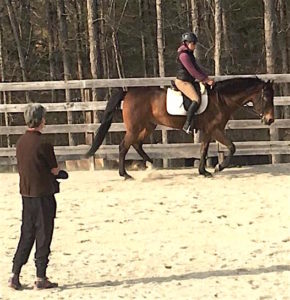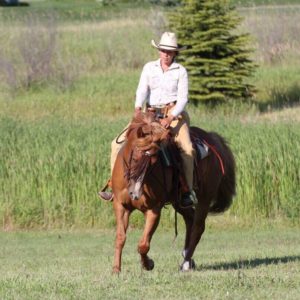Editor’s Note: Amy Skinner is a regular guest columnist for NickerNews and BestHorsePractices and has been a horse gal since age six. She rides and teaches dressage and horsemanship. Skinner has studied at the Royal Andalusian School of Equestrian Art in Spain, with Buck Brannaman, Leslie Desmond, Brent Graef, and many others.
Read more about Amy here.
Amy writes:
I stood in the pen with the anxious mustang, watching him pace back and forth, turning his head away to avoid the pressure of my presence. Every time I walked down toward his pen, before I even touched the gate, his pacing would start. I walked up quietly, getting as close as I was able to before he moved away. Where I stood, about 10 feet from him, he was not feeling so much pressure that he had to leave, but enough to make him uncomfortable. I waited there, looking for him to let down and find relaxation with me there.
Previously, when he’d stayed around with me that close, I’d turn around and leave him, letting him relax that way. But now I was beginning to realize that what I’d taught him was to find relaxation when I moved away. Now I was interested in having him find relaxation here and with me. In a few minutes, he let his head down and yawned. Instead of leaving, I stayed there a bit longer, letting him enjoy this mental softness he found with me.
 In riding as well, we should seek to help the horse find relaxation within a cue or movement. So much riding is based on escape and finding relief by avoidance:
In riding as well, we should seek to help the horse find relaxation within a cue or movement. So much riding is based on escape and finding relief by avoidance:
- You ask your horse to go and kick with a leg or spur. He reacts by moving forward. You release your leg. He finds relief, not from the cue but from the release of the cue.
- Similarly, you ask your horse to turn or stop and he knows that to relieve pressure from the rein he must move his body in a way to find relief away from that cue.
For a nervous or worried horse, these cues – leg, rein, or anything – can get them tense and reactive. When we reward by the release of a cue, that pattern may only exacerbate the tension. Just like the mustang finding relief when I leave, reaction-based release teaches the horse that he gets rewarded for holding tension. You may find that he finds this tension more and more often under saddle.
In dressage, we hear words like get the horse in front of the leg or get him off your aids.
A horse that is in front of your aids is one that is escaping a driving cue. That leaves the rider behind, with late timing, and unable to influence the horse where they are at that moment. A horse that is off the aids is one that reacting to the leg or hand.

The teacher gets a lesson. Skinner works with dressage instructor Theresa Doherty
A horse that is taught to come to the aids and find suppleness and relaxation learns to find peace with you. The horse that comes to the aids is not only a joy to ride, but is truly safe, because he wants to be with you, under your seat and with your hand. He is soft and relaxed, mentally and physically. One that reacts to escape a cue is moving in tension, and a tense horse can never be completely safe.
What I seek to ride and train into a horse is a suppleness and relaxation. I’d really like my cue to be the thing that brings relaxation to that horse, like the mustang stretching his neck and yawning while I stood by him. This means that I ask without tension in my body. While asking the horse with a relaxed and well-timed feel, I leave the feel there for the horse to follow, stay with, and enjoy.
There are, of course, small releases, and every conversation is fluid and dynamic. But my legs, seat, and hands are there for the horse to feel and find comfort in.
 The horse learns to feel your seat, your legs, your hands, and not to escape it but to seek and stay with the cues for comfort, because ideally they promote relaxation. Ideally, you then have a horse that sees you and finds comfort, feels you and reaches for you because you have always provided peace within the movements, not just after they are finished.
The horse learns to feel your seat, your legs, your hands, and not to escape it but to seek and stay with the cues for comfort, because ideally they promote relaxation. Ideally, you then have a horse that sees you and finds comfort, feels you and reaches for you because you have always provided peace within the movements, not just after they are finished.